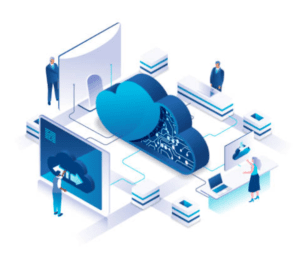How Startups Can Leverage Cloud Computing for Growth: A Phase-by-Phase Guide
Cloud Computing and the Phases in Life of a Startup#

Innovation and startups are usually synonymous, and with it comes economic growth. A startup evolves through different phases to strive for success. Each phase requires crafted architecture, appropriate tools, and resources for good results.
So, if you have a startup looking for help, you are at the right place. In this guide, let's discuss a startup's key phases. Also, let's check out the structural considerations, tools, and resources required.
Phase 1: Idea Generation#
The first step in a startup's journey is where everything begins. It's when you come up with your business concept and plan. During this phase, you need a flexible and affordable setup.
Key components include:
Website and Landing Page Hosting:#
Host your website and landing page on cloud servers to save money and adapt to changes.
Servers like:
- Amazon Web Services
- Microsoft Azure
- Google Cloud Platforms are reliable servers.
Collaboration Tools:#
Use tools like Slack, Trello, and Google Workspace for smooth teamwork from anywhere.
These tools help with real-time communication, file sharing, and project management.
Development Tools:#
Cloud-based development helps speed the creation of prototypes and initial product versions. These platforms support version control, code collaboration, and continuous integration, reducing time-to-market. Platforms, for example, GitHub and GitLab.
Phase 2: Building#
During this phase, startups turn their ideas into reality. They do so by creating and launching their products or services.
The architecture in this phase should be scalable and reliable. Tools and resources include -
Scalable Hosting Infrastructure:#
Cloud computing services provide scalable infrastructure to handle increased traffic and growth.
Solutions you can go for:
- AWS Elastic Beanstalk
- Google App Engine
- Microsoft Azure App Service offers managed hosting environments.
Cloud-Based Databases:#
Secure, scalable, and cost-effective cloud-based databases are crucial for data storage and retrieval. Amazon RDS, Google Cloud SQL, and Azure SQL Database are popular startup choices.
Development Platforms:#

Cloud-based development platforms offer the tools needed to build and deploy applications. Platforms such as:
- AWS Lambda
- Google Cloud Functions
- Azure Functions
These allow startups to create server-less applications, reducing operational complexity.
Phase 3: Product Launch#
The launch phase marks the introduction of the startup's product or service to the market. It demands an architecture that can handle sudden spikes in user activity.
Key elements include:
Infrastructure Scaling:#
Cloud services allow startups to scale up to meet the demands of new customers. Auto-scaling features in AWS, Google Cloud, and Azure adjust resources based on traffic.
Load Balancers:#
Cloud-based load balancers distribute traffic across servers, ensuring high availability and performance. Some examples of balancers are:
- AWS Elastic Load Balancing
- Google Cloud Load Balancing
- Azure Load Balancer
Security Measures:#
For securing your startup against cyber threats during this phase, you can take the help of:
- Cloud-based firewalls
- Web application firewalls (WAFs)
- Security groups.
For common threats, you can use:
- AWS WAF
- Google Cloud Armor
- Azure Web Application Firewall
Phase 4: Expansion#
In the growth phase, startups experience rapid expansion and an increasing customer base. The architecture must accommodate this growth. Tools and resources include:
Continued Scaling:#
Cloud computing services allow startups to keep up with client's growing demands. Auto-scaling and server-less architectures allow startups to divide resources.
Adding New Features:#
Startups can scale and enhance their offerings using cloud resources and development tools. Tools like Docker and Kubernetes make it easier to roll out new functionalities.
Market Expansion:#
The global reach of cloud infrastructure allows startups to enter new markets. Content delivery networks (CDNs) like:
- AWS Cloud Front
- Google Cloud CDN
- Azure CDN
These ensure fast and reliable content delivery worldwide.
DevOps as a Service#
In the startup lifecycle, Extended DevOps Teams play an essential role. DevOps practices ensure smooth development, deployment, and operations. DevOps as a service provides startups with the following:
Speed:#
Immediate adoption of DevOps practices speeds up development and deployment cycles. Continuous integration and continuous delivery (CI/CD) pipelines automate software delivery.
Expertise:#
Access to experienced professionals who can put in place and manage IT infrastructure. Managed DevOps services and consulting firms offer guidance and support.
Cost-Effectiveness:#
Outsourcing DevOps is cost-effective to maintain an internal team. You can lower the operational cost With pay-as-you-go models and managed services. Companies can tap into the expertise of skilled DevOps professionals without any issues. This approach ensures flexibility and scalability, allowing businesses to adapt to changing needs. By outsourcing DevOps services, organizations can:
- Optimize their resources
- Focus on core competencies.
- Achieve a more streamlined and cost-efficient development and operations environment.
Cloud Management Platforms#
Cloud management platforms offer startups:
Visibility:#
Startups gain a centralized interface for overseeing all their cloud resources. Cloud management platforms offer visibility into resource usage, cost monitoring, and performance metrics.
Control:#
The ability to configure, manage, and optimize cloud resources to meet specific needs. Infrastructure as code (IaC) tools like:
- AWS Cloud Formation
- Google Cloud Deployment Manager
- Azure Resource Manager
These will allow startups to define and automate their infrastructure.
Security:#
Protection against cyber threats to secure the cloud environment and safeguard valuable assets. Cloud security services such as:
- AWS Identity and Access Management (IAM)
- Google Cloud Identity and Access Management (IAM)
- Azure Active Directory (AD)
These enhance identity and access management.
Nife's Application Lifecycle and Cloud Management Platform#
Nife is an application that serves as a life cycle management tool, offering worldwide support for software deployment and cloud management. Our state-of-the-art arrangements engage undertakings and engineers to consistently send off and scale applications inside the Nife Edge Matrix.
Improve on the intricacies of 5G, edge figuring, and cloud with our set-up of APIs and devices, guaranteeing security, protection, and cost productivity.
Conclusion#
The journey of a startup is akin to a dynamic and ever-evolving process, with each phase presenting unique challenges and opportunities.
To navigate this ever-shifting landscape effectively, a strategic approach that leverages cloud computing services and DevOps expertise is indispensable.
In the initial stages, startups often grapple with resource constraints and rapidly changing requirements. Cloud computing services provide scalability and flexibility, allowing them to adapt to evolving demands without massive upfront investments. This elasticity is critical for cost-effective growth.
As a startup matures and product or service offerings solidify, DevOps practices become essential. The synergy of development and operations accelerates the development cycle, leading to faster time-to-market and increased customer satisfaction.
It also facilitates continuous integration and delivery, enabling frequent updates and enhancements to meet market demands.
In conclusion, the startup journey is a multifaceted expedition, with each phase requiring specific tools and strategies.
Cloud computing and DevOps, hand in hand, provide the adaptability, efficiency, and innovation needed for startups to thrive and succeed in a constantly changing business landscape. Their synergy is the recipe for a prosperous and enduring entrepreneurial voyage.














